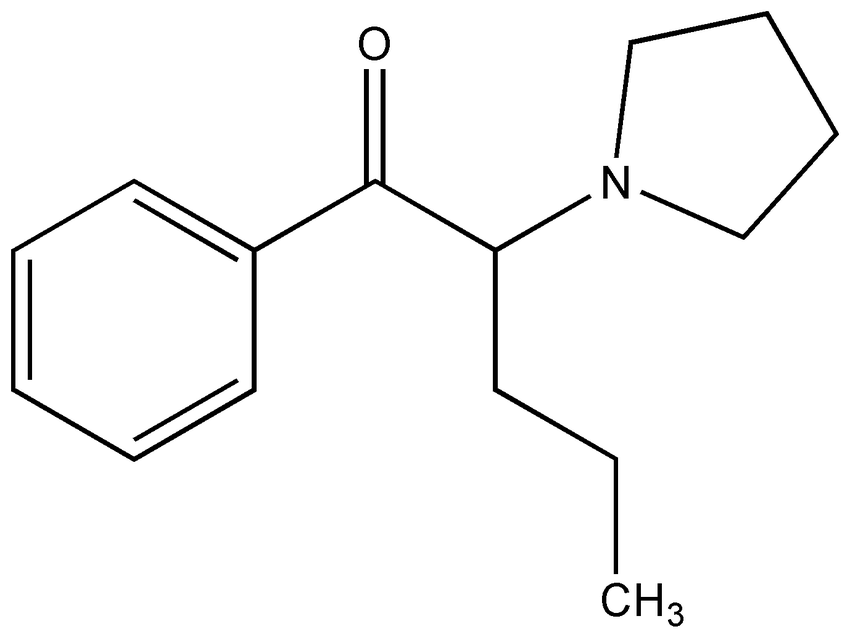
Α-Pyrrolidinopentiophenone
History
Α-Pyrrolidinopentiophenone was developed by the German pharmaceutical company Boehringer Ingelheim in the 1960s as a central nervous system stimulant.However, its illegal use as a recreational psychostimulant began about 10 years ago in the USA, Europe (Norway, Denmark, Finland, Iceland, Sweden) and Japan. The substance is often sold under the guise of “bath salts”.
In 2016, information began to spread in the American media that alpha-PVP turns people into “zombies”. In the US state of Florida, there have been cases of aggressive behavior and cannibalism, the reason for which the authorities called the use of α-PVP, but subsequent drug tests did not confirm these statements.Reports that this psychostimulant can turn into a “zombie” were used by the authorities as anti-drug propaganda.
Features
Α-Pyrrolidinopenthiophenone in the form of highly purified hydrochloride is a white crystalline powder..
Stereochemistry
Α-PVP has an asymmetric center in its molecule, as a result of which it exists as a pair of enantiomers. Thus, the product obtained as a result of conventional synthesis is actually a racemate (a mixture of two stereo isomers).

Basic information
Α-Pyrrolidinopentiophenone is a recreational psychoactive substance, the main effect of which is psychostimulation. When taking the substance, a person experiences the following effects: euphoria, talkativeness, fussiness, increased concentration, increased libido and sexual arousal, as well as general well-being.
The intense feeling of pleasure lasts 30-45 minutes, peaking 1.5 hours after ingestion. The main effects disappear after about 4 hours, the overall “desirable” experience lasts more than 6-8 hours.
Side effects
Side effects can be both serious and life-threatening, and fatal cases due to myocardial infarction have been recorded. Death occurs from an overdose of a psychostimulant. Some researchers have found psychopathological effects in users such as psychotic behavior, delusions and hallucinations, self-harm, confusion, anhedonia, anorexia, panic attacks. Other negative effects relate to the cardiovascular system: palpitations, hypertension, shortness of breath, vasoconstriction, arrhythmia, myocarditis and myocardial infarction. In addition, body temperature may rise to 40-41 ° C, rhabdomyolysis and renal failure may occur.
Neurological signs include headache, seizures, paresthesia, tremor, dystonic movements, amnesia, cerebral edema, parkinsonism and stroke.
Slang names
The psychostimulator has a popular name “flakka”, which is used in some European countries and the USA. It comes from the Spanish flaco/-a — thin. The prevalence of the name “flakka” was reported by the European Monitoring Center for Drugs and Drug Addiction, in addition, they mentioned “crystal love” (crystal love), “gravel” (gravel), “Pure NRG” (clean energy), “vanilla sky” (vanilla sky) and “Snow Blow” (inhaling snow; “snow” is also called cocaine). Only two popular alpha-PVP slang names were reported from the USA: “flakka” (flakka) and “gravel” (gravel). However, in addition to them, the WHO (World Health Organization) reports list several dozen more slang names from European countries.
Dosages
Α-Pyrrolidinopentiophenone is active in dosages starting from 1 mg. For intranasal use, a light dosage is 1-5 mg, an average dosage is 5-15 mg, and a strong dosage is 15-25 mg. When taken orally, a light dosage is 5-10 mg, an average one is 10-25 mg, and a strong one is 25-40 mg.
The cost on the black market
According to American drug experts, α-PVP is usually ordered from Chinese companies at a price of about $ 1,500 per kilogram, and is sold inside the United States at a price of $ 50,000.
Interactions
First of all, interactions with microorganisms, there is evidence that living organisms can sense this substance. The relationship with human skin is to absorb the structure of DNA.
Subsequently, it has a negative effect on thinking and mind.
The combination of α-PVP with antidepressants (selective serotonin reuptake inhibitors, monoamine oxidase inhibitors) and 5-HTP is dangerous, as it can cause serotonin syndrome.
Combination with methoxetamine (MXE) or dextromethorphan (DXM) can cause an increase in heart rate and blood pressure.
Combination with tramadol increases the risk of seizures.
Mechanism of action
The class of α-pyrrolidinophenones stimulates the central nervous system by selectively inhibiting dopamine and norepinephrine transporters, while the effect on serotonin transport is negligible.
Synthesis
The synthesis of α-PVP begins with the α-halogenation of the valerophenone precursor (1-phenylpentane-1-one) using bromine. 2-bromo-1-phenylpentane-1-one is formed. Then its reaction with pyrrolidine yields α-PVP. Valerophenone can be synthesized from benzaldehyde or benzene and other precursors.
There are also alternative synthesis methods:
the reaction of bromavalerophenone (2-bromo-1-phenyl-pentane-1-one) with alcoholic reagents to obtain an intermediate product of epoxide. The epoxide then reacts with pyrrolidine to produce α-PVP;
Grignard reaction between 2-(pyrrolidine-1-yl)pentanamide and phenylmagnesium halide;
oxidation of the precursor 1-phenyl-2-(pyrrolidine-1-yl)pentane-1-ol.
Metabolites
In studies of the metabolites into which α-PVP breaks down in the body, two main types were identified:
1-phenyl-2-(pyrrolidine-1-yl)pentane-1-ol (or OH-α-PVP) and
α-(2″-oxo-pyrrolidino)valerophenone (or 2″-oxo-α-PVP), presumably occurring through the intermediate α-(2″-hydroxypyrrolidino)valerophenone (or 2″-OH-α-PVP).
1-phenyl-2-(pyrrolidine-1-yl)pentane-1-ol (OH-α-PVP) is a diastereomer.
Then, experts reliably established that there are two metabolic pathways and three types of metabolites, including diastereomers.
Metabolites were found in the urine of people abusing stimulants, while gas chromatography-mass spectrometry and valid procedures with liquid chromatography in tandem with mass spectrometry were used in the laboratory.
According to the researchers, their discovery is an important event that will serve to determine the causes of death or poisoning in toxicological and forensic institutions.
Legal status
In the 1970 UN Convention on Psychotropic Substances, α-PVP is listed in Schedule II.
The U.S. Drug Enforcement Administration temporarily placed 10 synthetic cathinones, including α-PVP, on List I of Controlled Substances in 2014.
In Germany, the drug is in Schedule I (German: Anlage I), only scientific research of the substance is allowed.

